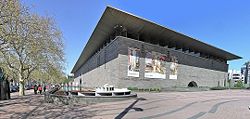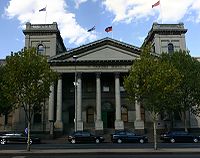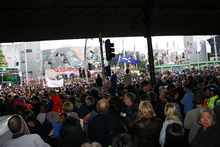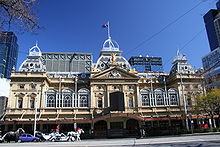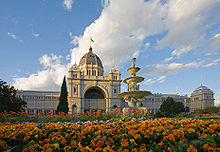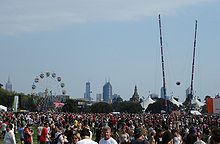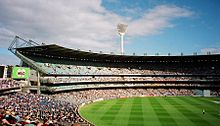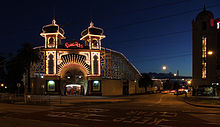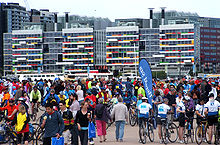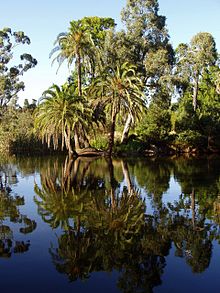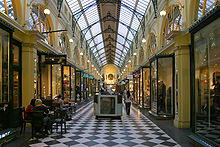- Culture of Melbourne
-
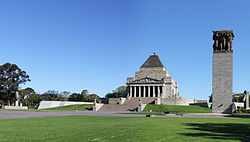 The Shrine of Remembrance is an important cultural landmark. Melbourne's largest war memorial built from money raised by public contributions.
The Shrine of Remembrance is an important cultural landmark. Melbourne's largest war memorial built from money raised by public contributions.
The Culture of Melbourne (the capital of Victoria, Australia) reflects its diverse, multi-layered culture and society and the city is widely noted as the "cultural and sporting capital" of Australia.
Melbourne's culture draws on Western culture and the culture of Australia, and cultures of the world, however it branches into its own local culture through a number of local traditions and strong themes with the Melburnian emphasis on the arts (particularly the performing arts, culinary arts and visual arts) as well as sport, sporting traditions and recreation. Melbourne is also a major centre of activism, including the Australian trade union movement.
Melbourne has many cultural institutions, such as museums and galleries, events and festivals, public/street art, popular music, live music, film, independent music and independent film and fashion.
The city celebrates a wide variety of major annual cultural events from local to national and international events.
Melbourne has thrice shared top position in a survey by The Economist of the World's Most Livable Cities on the basis of - its cultural attributes; climate; cost of living; and social conditions such as crime rates and health care, in 2002,[1] 2004 and 2005.[2][3]
Melbourne has a number of cultural hubs including the Victorian Arts Precinct with its distinctive spire and Federation Square which has become one of the city's main cultural hubs and tourist centres with its distinctive architecture, large digital screen and public space it attracts congregations, rallies and public viewing of sporting events.
Contents
Festivals and events
Melbourne is home to a range of international festivals, most notably the Melbourne International Comedy Festival, Melbourne International Film Festival, Melbourne International Arts Festival, Melbourne International Flower and Garden Show, Melbourne International Air Show and the Melbourne International Animation Festival.
- The Royal Melbourne Show is a Melbourne tradition since 1848.
- Boxing Day Test has been a Melbourne cricket tradition since 1950.
- Myer Christmas Windows began in 1956 and later the Myer Christmas Parade.
- Moomba is an annual festival which began in 1955 and celebrates the Yarra River, the Birdman Rally is also a Melbourne tradition.
- Several Melbourne traditions have developed around Australian rules football (either by embracing or rejecting it), particularly the annual AFL Grand Final sporting event, including the Grand Final Parade and the Punk Pub Crawl.
- ANZAC Day parade to the Shrine of Remembrance and also the Anzac Day clash.
- Melbourne Spring Racing Carnival
- Melbourne Fringe Festival
- Midsumma
- Melbourne Winter Masterpieces
- St Kilda Festival
- Melbourne Jazz Festival
- Melbourne Food and Wine Festival
- Brunswick Street Street Party/High Street Street Party
- Big Day Out Music Festival
- Sydney Road Street Party - Brunswick Music Festival
Several national traditions originated in Melbourne: The Melbourne Cup has been a Melbourne tradition since 1861 and then became a national tradition - the "Race that Stops the Nation";Carols by Candlelight, first held in 1938, is a Christmas Eve tradition; Myer Christmas Windows; and the AFL Grand Final.
There are a number of cultural festivals which celebrate foreign cultures in the context of the city's culture. Major festivals for Melbourne's large ethnic communities include:
- Greek Antipodes Festival
- Melbourne Italian Festival
- Asian Food Festival
- Australian Chinese New Year
Parades and protests
Melbourne's original plan, the Hoddle Grid was designed to be devoid of public meeting spaces and squares in a bid by Governor Gipps to discourage democracy. However Melburnians have defied this anti-democratic planning with a history punctuated by public cultural expression and vocal activism.
The city's wide thoroughfares became the conduit for the city's parades, marches and rallies. Swanston Street and Bourke Street are regarded widely as the civic spines of the city. More recently, Federation Square has become such a venue.
Some of the largest demonstrations in the southern hemisphere have taken place in Melbourne.
- 2005 Industrial relations demonstration - 250,000
- 2003 Anti-Iraq War demonstration - 150-200,000
- Melbourne Vietnam Moratorium - 150,000
- Save Live Australian Music rally - 20-50,000
Trade unionism
Melbourne is regarded as the home of the Trade Unionist movement in Australia, with the Australian Council of Trade Unions being headquartered in the city and the Australian Eight-hour day began in Melbourne.
The Eureka flag (of the Eureka Rebellion), a Victorian emblem is often used by protest groups.
Melbourne has a particularly punctuated history of strike action.
Arts
Melbourne has a vibrant arts scene, hosting the annual Melbourne International Arts Festival as a celebration of its artistic tradition.
Opera and theatre
The Australian Ballet are based in Melbourne. The National Theatre in St Kilda is the oldest ballet school in Australia. Ballet regularly features at the Victorian Arts Centre and the National Theatre. Melbourne is the second home of Opera Australia after it merged with 'Victoria State Opera' in 1996. The Victorian Opera had its inaugural season in 2006 and operates out of various venues in Melbourne.
The Royal Melbourne Philharmonic was formed in 1853, making it Australia's oldest continuously existing musical organisation and the only orchestra in Australia to be bestowed 'royal' status. The Victoria Orchestra, based in Melbourne was Australia's first professional orchestra and performed during 1888–91. The Melbourne Symphony Orchestra, first assembled in 1906, is now the city's premier orchestra and tours internationally.
There are more theatres and performance venues in Melbourne than any other city in Australia. The most notable include: the Melbourne Recital Centre, David Marriner's Princess Theatre, Regent Theatre, Forum Theatre, and the Comedy Theatre; the Athenaeum, Her Majesty's Theatre, State Theatre, Capitol Theatre, Palais Theatre and the Australian Centre for Contemporary Art. Several professional theatre companies operate in Melbourne, of which the Melbourne Theatre Company, the oldest professional theatre company in Australia, has the most institutional support of any in Australia. There is also a range of smaller professional theatre companies in Melbourne, including the Malthouse, La Mama in Carlton, Cariad Productions, the Red Stitch Actors Theatre and Theatreworks in St Kilda and an array of amateur companies that produce a professional standard of musical and straight theatre, such as OXAGEN Productions, the Malvern Theatre Company, CLOC, Catchment Players of Darebin, Altona City Theatre, Windmill Theatre Company and Dandenong Theatre Company.
Melbourne has a large number of buskers (also known as street performers) that perform in the CBD and surroundings. Melbourne's musical buskers cater to a wide variety of tastes, from rock to world music and indigenous Australian traditions. However, not all buskers are musicians. There are also living statues, street artists and jugglers.
Melbourne is known throughout Australia and the world as a centre of comedy. The Melbourne International Comedy Festival is one of the three largest stand-up comedy festivals in the world.[4] The city is also home to many of Australia's top rating comedy television shows and many of the country's leading comedians either come from the city or call it home.
Melbourne will also be the host of the 2008 World Latin American Dance Championships.[5] The competition will be housed in the Vodafone Arena and will be held immediately after the Australian Dancesport Championships. The Australian Dancesport championships will commence on the 10th of December and the World Latin Championships will be held on the 14th of December.
Melbourne-born satirist Barry Humphries created his main character Dame Edna Everage as a comic version of a suburban homemaker. Through her, Humphries has written and performed cutting odes to Melbourne mores and the middle class suburbs of Moonee Ponds and Highett, among others.
Visual arts
The Heidelberg school in Melbourne, largely the work of Melbourne-based artists was the first significant art movement in Australia, beginning in the late 1880s.[6] Many of its most significant works are held in the National Gallery of Victoria, one of Australia's premier collections of visual art. The strong art community culminated in significant artist colonies such as Heidelberg and Montsalvat.
There are more than 100 galleries in Melbourne.[7] In the city, NGV International and the Ian Potter Centre and Ian Potter Museum of Art, Australian Centre for Contemporary Art, and Flinders Lane Gallery, Anna Schwartz Gallery, McCulloch Gallery, and Australian Centre for the Moving Image- an organisation dedicated to the moving image in all its forms, from film to animation to video games and television. In inner city Fitzroy, Gertrude Contemporary Art Spaces, and Centre for Contemporary Photography. In Heidelberg, Heide Museum of Modern Art. List of galleries in Melbourne: ART ALMANAC
Melbourne is home to a large array of public artworks, statues and sculptures. Sculptors such as Deborah Halpern have played a large part in enhancing many of the city's public spaces with their iconic and larger-than-life works. In more modern times, the city has become well known for stencil graffiti,[8] public art that appears in the city's numerous laneways.
The city has major film festivals including the Melbourne International Film Festival, Melbourne Queer Film Festival, Melbourne Underground Film Festival and Melbourne International Animation Festival, featuring several of the city's major cinemas. The Central City Studios in Melbourne Docklands, constructed in 2005, has seen the production of several big budget films.
Melbourne is also known for fashion. The city, once a leader in the textile industry, retains a small manufacturing base, but has diversified into the more creative areas of the fashion industry.[9] The Melbourne Fashion Festival is an annual event held in the city. The Melbourne Spring Racing Carnival, Logies and Brownlow Medal dinner are among the biggest annual red carpet events in the country.
Street Art in Melbourne is internationally recognised, the city hosting the worlds first street art festival. Many international visitors coming to see and participate in the street art culture. Many suburbs of Melbourne now protect large areas of what was previously thought of as vandalism. International artists such as Banksy place work in Melbourne.
Architecture
Melbourne has a wide variety of architectural design. Australia's oldest architectural firm, and one of the world's oldest, Bates Smart, is from Melbourne. The city is home to the first building in Australia to be listed on the World Heritage Register, the Royal Exhibition Building.[10]
Melbourne has also been home to some of Australia's most prolific architects including Joseph Reed, William Wardell, John James Clark, Charles D'Ebro, Charles Webb, William Pitt, Nahum Barnet, Harry Norris, Sir Roy Grounds and Robin Boyd. In recent years, Melbourne has produced some of Australia's best current architectural firms, including international firms Denton Corker Marshall, Fender Katsalidis, Daryl Jackson and Peddle Thorp as well as local award winning trendsetters Edmund & Corrigan, Ashton Raggatt McDougall and Wood Marsh.[11]
Literature
There is a greater number of bookshops per capita in Melbourne than any other Australian city.[12]In August 2008, Melbourne was designated as a City of Literature in UNESCO's Creative Cities Network program, recognising the role literature plays in the cultural life of Melbourne through its festivals, libraries, bookshops, publishing and other literary events and activities.[13]
The Melbourne Writers Festival plays a significant role in establishing Melbourne's credence as a city which promotes and respects literature.
The Wheeler Centre a literary and publishing centre housed in the southern wing of the State Library of Victoria opened in February 2010.[14]
Music
Melbourne has one of the most highly regarded live music scenes in the world. In terms of the quality and number of venues, arguably, it is comparable with cities such as Austin. It hosts extensive commercial and independent music industries, as with many cities around the world, its independent music scene is growing rapidly as commercial record labels find it increasingly difficult to market and sell music as a product, an increasing number of people are choosing to recognise and appreciate music as a form of art rather than a product.
Hundreds of venues throughout Melbourne host live music, some of which host live music every night of the week.
Singer Paul Kelly has written several well-known songs about aspects of the city close to the heart of many Melburnians, notably "Leaps And Bounds" and "From St Kilda To King's Cross", while Skyhooks also wrote some more tongue-in-cheek songs about Melbourne. "Balwyn Calling", "Carlton (Lygon Street Limbo)" and "Toorak Cowboy" are examples. Melbourne-originated indie-rock band The Living End wrote the song "West End Riot" about differences between eastern and western suburbs in Melbourne's inner city. Melbourne has produced many popular international vocalists and singers, including 1900s soprano Dame Nellie Melba, who took her name from her native city, who in turn had a suburb in Australia's capital city Canberra named after her (see Melba, Australian Capital Territory).
In the late 1970s, Melbourne's independent music scene flourished with strong support from local venues, street press, community radio (such as PBS, 3RRR, 3CR) and an abundance of independent record labels. The city's inner suburbs were home to several distinct post-punk scenes that each shared a DIY ethic and passion for experimentation.[15] Led by the Primitive Calculators and Ollie Olsen's Whirlywirld, the "North Fitzroy Beat" and interrelated Little Band scene gave rise to Hunters & Collectors, and Lisa Gerrard of Dead Can Dance. In Clifton Hill, an underground arts space known as "The Organ Factory" facilitated collaborations between conceptual composers, such as David Chesworth and Philip Brophy, and experimental punk outfits, namely Tsk Tsk Tsk, Essendon Airport, and the funk-tinged I'm Talking, which launched the career of singer Kate Ceberano. St. Kilda's Crystal Ballroom became the stomping ground for Melbourne's darker "proto-gothic" groups including The Moodists, Crime and the City Solution, and Nick Cave's The Birthday Party, one of the 80s' most influential bands.[16] In 1983, Cave and Melbourne-born industrial pioneer Clint Ruin (aka Foetus) formed the "No Wave supergroup" The Immaculate Consumptive. The same year, Cave and Birthday Party bandmate Mick Harvey founded one of Australia's most popular and enduring rock bands, Nick Cave & The Bad Seeds, whose evolving multinational lineup has included Melbourne musicians Hugo Race, Anita Lane, and Dirty Three violinist Warren Ellis.
Many independent artists from Melbourne have become internationally notable and regularly tour abroad, including: The Temper Trap, Cut Copy, Architecture in Helsinki, The Drones, Grinderman, Augie March, New Buffalo, The Cat Empire, Dirty Three, Muscles, The Lucksmiths, Ned Collette, The Crayon Fields, Love of Diagrams, Midnight Juggernauts, Gotye and The Avalanches amongst others.
Melbourne's lively rock and pop music scene has fostered many internationally renowned artists and musicians. The 1960s gave rise to many performers including Olivia Newton-John, John Farnham, Graeme Bell, and folk group The Seekers. The 1970s and 1980s saw many acts getting their first big breaks on Melbourne's Countdown, including Nick Cave the Little River Band and Crowded House who later wrote a song about the city of Melbourne called Four Seasons In One Day. Successful Melbourne artists include Hunters & Collectors, Nick Cave, Flea (of the Red Hot Chili Peppers), Weddings Parties Anything, TISM, Dead Can Dance, Snog, Jet and Something for Kate. Melbourne is also the home of rock "guru" journalist Ian "Molly" Meldrum.
More recent notable Melbourne acts include Jet, Rogue Traders, Taxiride, Missy Higgins, Madison Avenue, Anthony Callea and The Living End. Melbourne-based television shows Young Talent Time and Neighbours gave many singers a launching pad to international success. Local talents to come from these shows include Kylie Minogue, Dannii Minogue, Tina Arena, Jamie Redfern and Jason Donovan. Another Music TV show that began in Melbourne was Turn It Up! It was first shown on Melbourne's Channel 31 and then relayed via satellite and rebroadcast terrestrially to major TV networks in over 22 countries. The show had the second largest viewing audience around the world, beaten only by the audience of American Bandstand. In one episode, the show presented Melbournes annual festival Moomba to a world audience.
Media
Melbourne has two major daily newspapers, Rupert Murdoch's Herald Sun and the Fairfax owned The Age, as well as the free afternoon tabloid mX which is published by Murdoch. A national Australian newspaper has a Victorian issue and is also published by Murdoch. Several weekly magazines are published by Murdochs' News Corp. As News Corp holds over 50 million shares in Fairfax,[17] there is no daily newspaper in Melbourne free of Rupert Murdoch's media empire. There are three commercial television networks: Seven, Nine and Ten; and three public: the ABC, SBS and a community television channel, C31. Leader Newspapers is Australia's largest publisher of community newspapers, distributing 33 local papers across Melbourne suburbs.[citation needed] More community newspapers are published by Fairfax Community Newspapers, and the Star News Group.
Melbourne's commercial radio industry is dominated by the DMG Radio Australia, Austereo and Southern Cross Broadcasting networks – all Melbourne-based. DMG Radio Australia stations include Nova 100 and Classic Rock, Austereo stations include FOX FM and Triple M. 3AW is consistently the city's highest-rating commercial radio station.[citation needed] Melbourne also boasts a number of community radio stations, of which the best known are 3RRR, 3PBS, 3CR, SYN, and JOY, the first Australian full-time gay and lesbian radio station. Public broadcasters include the multilingual SBS, and the ABC's Radio National, NewsRadio, and 774 ABC Melbourne.
Sport
See also: Sport in MelbourneIn a country that is often labelled 'sports mad', Melbourne has a reputation among Australians for being the national sporting capital.[18] In 2010, the city was named "World's Ultimate Sports City" for the third time in a row by SportAccord and SportBusiness.[19] Criteria for the award include "the number of annual sports events held, major events held or hosting rights secured between 2006 and 2014, numbers of federations hosted, facilities/venues, transport, accommodation, government support, security, legacy, public sports interest and quality of life."[20] A similar study conducted in 2006 by the London-based research and consulting firm ArkSports found Melbourne to be the world's top city for sports events.[21]
Melbourne is home to the National Museum of Sport.
The city hosts many major sporting events including the Melbourne Spring Racing Carnival (featuring the 'race that stops the nation', the Melbourne Cup), the Australian Formula One Grand Prix, the Australian round of the MotoGP, the Australian Open Tennis Championship, the AFL Grand Final and the Boxing Day Test Match. Melbourne hosted the first Olympic Games in the southern hemisphere in 1956, as well as the 2006 Commonwealth Games. Melbourne also played host to the 12th FINA World Aquatics Championships in 2007. In 2008, the city will host its first Asia Pacific Outgames which are set to take place between 30 January and 3 February.
Melbourne is where Australian rules football originated — the world's first codified game of football[22] and the most popular sport in Australia by attendance and viewership.[23] The city is home to nine of the sixteen teams that constitute the Australian Football League (AFL), whose five Melbourne games per week attract an average 40,000 people per game.[24] The AFL Grand Final, one of the biggest sporting events in Australia, is played on the last Saturday of September at the world famous Melbourne Cricket Ground (MCG),[25] The city also is home to nine out of the thirteen teams of the professional state wide Victorian Football League.
During the summer months cricket takes preference amongst Melburnians, with the annual Boxing Day Test Match, which is held at the Melbourne Cricket Ground, being the feature of the Melbourne summer. The Boxing Day Test is the largest attended annual Test Match in the world. The Melbourne Cricket Ground also hosts Victorian Bushrangers home Sheffiled Shield, One-Day and Twenty20 matches, which attract in excess of 40,000 fans.
Melbourne has professional teams in several codes: football, rugby league and union, basketball and netball. There are two A-League (association football) teams: Melbourne Victory and Melbourne Heart. In rugby there is Melbourne Storm (NRL), and Melbourne Rebels (Super Rugby). The Melbourne Tigers compete in the NBL (basketball). For netball, two Melbourne teams compete for the Commonwealth Bank Trophy: Melbourne Phoenix and Melbourne Kestrels.
Including the MCG, Melbourne is home to over 29 stadiums with a capacity of over 10,000 people. Some venues, such as the Albert Park Formula One track and the Calder Raceway, have large capacities but only temporary structures, while there are numerous suburban horse racing tracks and Australian Rules ovals. In 2000 construction was completed on the Docklands Stadium, capable of seating up to 56,000 people. The stadium was the first in the world to host cricket and football matches under a roof. Under naming rights changed, the stadium has gone from being originally the Colonial Stadium, then to Telstra Dome, finally to Etihad Stadium, adopted in 2009.
The city also has large State Cycling, Hockey, Baseball/Softball and Netball centres, and an Ice centre (National Ice Sports Centre, hosting the Australian Olympic Winter Institute) is being constructed in Melbourne Docklands.[26]
The city has hosted several major international sporting events. Annually, Melbourne hosts the Australian Open tennis tournament, one of the four Grand Slam tournaments and the AAMI Classic; the famous Melbourne Cup horse race; the 'Boxing Day' cricket test match held each year from 26 December to 30 December at the Melbourne Cricket Ground; and the Australian Formula One Grand Prix. The Wallabies, Australia's national rugby union team, and the Socceroos usually play at least one game annually in Melbourne. Since 1999, the city has been the biennial host of the International Rules series involving the Australian national team and the Irish national team. The city hosted the 2002 and 2005 Australian Football International Cup.
Since the 1956 Summer Olympics were held in Melbourne, the city has hosted numerous sporting events which rotate host cities. Melbourne co-hosted the 2003 Rugby World Cup, including many pool matches as well as a quarter final – all of which were played at the Etihad Stadium; hosted the 2002 World Masters Games; broke new ground as the first city outside the United States to host the World Police and Fire Games in 1995, and the Presidents Cup golf tournament in 1999; and was the first city in the Southern Hemisphere to host the World Polo Championship in 2001. The city has hosted FIFA World Cup qualifiers in both 1997 and 2001. Most recently, the 2006 Commonwealth Games were held in Melbourne. Seventy-one Commonwealth nations competed in the Games.
In July 2006, the Rugby League State of Origin, often considered the flagship event of Australian rugby league, was played at the Ethiad Stadium. The Rugby League State of Origin has been held several times before in Melbourne (most recently in 1997), and has attracted over 87,000 spectators at the MCG, even though Victoria is not actually one of the states involved. In 2006, the Kangaroos, Australia's national rugby league team, played a Tri-nations test at the Etihad Stadium, the first rugby league test in the city for 14 years. In December 2006, the 100th cricket test was played at the Melbourne Cricket Ground as part of The Ashes series attracting a sell-out crowd with as many as 40,000 English.[citation needed]
The Victorian government recently won the right to host the Bledisloe Cup rugby union Test in 2007 and 2011 at the MCG. The Australian Football International Cup returns in 2008 to celebrate 150 years of Australian rules football, as well as a much anticipated return to the AFL State of Origin series.[27]
The tennis arena of Rod Laver was converted in to the Susie O'Neill pool for the 2007 Swimming World Championships.
Recreation and leisure
Melburnians participate in a wide range of recreational and leisure activities.
Australian rules football, cricket and netball are the most popular participation team sports in Melbourne[citation needed].
Cycling in Melbourne is a popular pastime, as one can tell from the bevy of cyclists and paths that lie all throughout the city, as well as a spectator sport. Melbourne's flat terrain and extensive off-road paths in green wedges are conducive to riding. Beach Road combines with the Nepean Highway to form a 90-kilometre stretch from Port Melbourne to Sorrento, incorporating the Bayside Trail. It is the city's most popular training route and attracts cyclists from around the world. Thousands of commuters cycle the roads, bike lanes and bike paths daily. Bicycle Victoria's annual events, Around the Bay in a Day and Ride to Work Day, attract tens of thousands of Melburnians. Other events such as the Herald Sun Tour begin and end in the Melbourne area and there are many local cycling events of varying grades all year round.
Triathlon dominates the Beach Road area during summer, when hundreds of amateurs and professionals dive into Port Phillip Bay on Sundays.
Watersports are a big recreational activity in Melbourne. Rowing on the Yarra River is also popular with universities and schools, and there are many boat-sheds along the river. the Yarra is home to the Head of the River, first raced in 1868 and Australia's oldest. The Oarsome Foursome are also from Melbourne. On Port Phillip Bay, boating is popular[citation needed] , as is jetskiing, kitesurfing and windsurfing on St Kilda Beach.
 Port Phillip's many beaches are home to a wide range of recreational activities. (Pictured: Brighton's famous colourful bathing boxes, kitesurfers and the city skyline).
Port Phillip's many beaches are home to a wide range of recreational activities. (Pictured: Brighton's famous colourful bathing boxes, kitesurfers and the city skyline).
Parks and gardens
Melbourne is noted for its parks and gardens, with a ring of parks providing a green lung for the city centre. Perhaps the most notable is the Royal Botanic Gardens. Other notable gardens have been established on outskirts of Melbourne. In particular the Dandenong Ranges has the National Rhododendron Gardens, and several other public gardens. Residential gardening is a popular pastime in Melbourne, and Australia's Open Garden Scheme started in the city.
Entertainment
In Melbourne there is approximately 5000 cafes and restaurants - per capita Melbourne has the most cafes/restaurants in the world.[citation needed] Also, Melbourne has more clubs/pubs per capita than anywhere else in the world[citation needed]. Restaurants are numerous and present a diverse range of cuisines. The city has a reputation as a culinary capital,[28] celebrated by the annual Melbourne Food and Wine Festival. As well as the famous "Little Italy" of Lygon Street in Carlton, other favourite inner city dining locations for Melburnians include Fitzroy Street St Kilda, Brunswick Street Fitzroy, Victoria St Collingwood, the CBD, and the Docklands and Southbank precincts. In 2006, Jamie Oliver selected Melbourne as the location for "Fifteen Melbourne", the Australian restaurant for his reality television show Jamie's Kitchen Australia.
Dance music is a thriving part of the Melbourne scene. The largest nightclubs are the Melbourne Metro Nightclub (2500 capacity) and QBH (2100 capacity). Melbourne is the birthplace of the Melbourne Shuffle, a style of dance that has been exported to South East Asia and continues to evolve to date.
Shopping
Shopping or "retail therapy" has been a big part of Melbourne's way of life since the late 19th century, when "doing the Block" was a sign of prestige.[citation needed] Today, the city is home to some of Australia's best shopping strips, such as the famous Chapel Street which stretches many blocks through South Yarra and Prahran, while heritage arcades such as the Block and the Royal Arcade and the CBD's myriad lanes. The large Chadstone Shopping Centre markets itself as the "Fashion Capital". Strip shopping localities include Toorak Village, known for its exclusiveness, and Bridge Road in Richmond, known for its extensive factory outlets. Also there are major shopping centres throughout metropolitan Melbourne such as Westfield Airport West, Westfield Southland, Westfield Doncaster, and Knox City Shopping Centre.
Melbourne is also home to the Queen Victoria Market. This market contains both indoor and outdoor sections.
Film and drama
See also: List of movies filmed in MelbourneMelbourne has been the setting for many novels, television dramas, and films. Fergus Hume's international best-seller Mystery of a Hansom Cab was set in Gold Rush era Melbourne. Frank Hardy's Power Without Glory tells the story of Melbourne businessman John West (based on the real-life John Wren) and is set in a thinly-disguised Collingwood, then a working-class suburb of Melbourne. Perhaps the best-known novel internationally is Nevil Shute's novel On the Beach. In 1959, it was made into a film directed by Stanley Kramer and starring Gregory Peck, Ava Gardner and Anthony Perkins. The film depicted the denizens of Melbourne quietly slipping off into eternity as the last victims of a global nuclear holocaust. It was filmed on location in and around Melbourne. Similar filming was undertaken when a 2000 television movie remake was produced.
The world's first feature film, The Story of the Kelly Gang, was filmed in Melbourne in 1906.[29] Some of the more famous Australian films include Mad Max and The Castle. Melbourne has also produced many talented film and television actors including Cate Blanchett, Guy Pearce, Eric Bana and is home to Geoffrey Rush.
Australian audiences saw Melbourne portrayed in the 1960s–70s Crawford Productions police television drama series Homicide and Division 4. Contemporary series include: soap opera Neighbours, Stingers (an undercover police drama), The Secret Life of Us, Kath and Kim, Prisoner (known as Prisoner: Cell Block H for US and UK broadcasts), Halifax FP, and MDA.
See also
- Culture of Australia
- Melbourne
- Media in Melbourne
- List of songs about Melbourne
- List of movies filmed in Melbourne
- Parks and gardens of Melbourne
- Sport in Victoria
- Melbourne street art
- Melbourne performing art venues
References
- ^ Melbourne and Vancouver are the world's best cities to live in Economist Intelligence Unit (2002).
- ^ Vancouver Melbourne and Vienna named world's most liveable cities Economist Intelligence Unit (2005).
- ^ Melbourne 'world's top city', The Age
- ^ Marketing report, 20th Melbourne International Comedy Festival, 2006
- ^ Melbourne plays host to World Latin Championship
- ^ Australian painters from cultureandrecreation.gov.au
- ^ "Art Galleries, Melbourne". Visit Melbourne. Tourism Victoria. http://www.visitmelbourne.com/Regions/Melbourne/Activities-and-attractions/Art-theatre-and-culture/Art-galleries.aspx. Retrieved 25 July 2011.
- ^ Melbourne Stencil Art Map
- ^ Modern Australian Fashion from cultureandrecreation.gov.au
- ^ Royal Exhibition Building and Carlton Gardens - UNESCO World Heritage Centre
- ^ Designers front up to world stage
- ^ "Books and Magazines, Melbourne". Visit Melbourne. Tourism Victoria. http://www.visitmelbourne.com/Regions/Melbourne/Activities-and-attractions/Shopping/Books-and-magazines.aspx.
- ^ International: Cities of Literature
- ^ ABC:Wheeler Centre's Gala Night Of Storytelling, 24 Feb 2010, retrieved 23 August 2010
- ^ Do That Dance! Australian Post Punk 1977-1983, abc.net.au. Retrieved on 30-10-2010.
- ^ Brokenmouth, Robert (1996). Nick Cave: The Birthday Party & Other Epic Adventures. London: Omnibus Press. ISBN 0711956014.
- ^ Murdoch's Fairfax raid 'an investment'
- ^ Transcript of the Prime Minister. The Hon John Howard MP. Address at the launch of the Melbourne Commonwealth Games 2006
- ^ Langmaid, Aaron (28 April 2010). "We're sport's champion city again". Herald Sun. Retrieved on 20 February 2011.
- ^ Cutler, Matt (27 April 2010). "Melbourne retains the SportBusiness ‘Ultimate Sports City’ award". SportBusiness. Retrieved on 21 February 2011.
- ^ "We are world's sports capital". Herald Sun (News Limited). 12 November 2006. http://www.news.com.au/heraldsun/story/0,,20741948-661,00.html. Retrieved 28 November 2006.
- ^ Giulianotti, Richard (2005). Sport: A Critical Sociology. Cambridge: Polity. p. xiv. ISBN 0745625460.
- ^ Sports Attendance, Australia, 2005-06, Australian Bureau of Statistics
- ^ AFL blueprint for third stadium
- ^ "MCG – Article". MCG. Archived from the original on 3 October 2006. http://web.archive.org/web/20061003171327/http://www.mcg.org.au/default.asp?pg=historydisplay&articleid=38. Retrieved 5 October 2006.
- ^ Media Release: Melbourne Ice-Sports Centre Consortium Announced
- ^ AFL pushes state-of-origin
- ^ Europe on a plate Article from the Adelaide Advertiser
- ^ The Premier of Victoria
External links
- That's Me!bourne - Melbourne tourism website
- Arts Victoria
- Melbourne Festival
Events in the Melbourne City Centre Note: this includes events held in the Melbourne City Centre and its fringe areas, not the Greater Melbourne metropolitan area Summer All: Summer Fun in the City of Melbourne
December: Australian Dancesport Championships • Australian Film Institute Awards • Boxing Day Test • Carols by Candlelight • Myer Christmas Parade
January: Australian Open • Midsumma Festival • Melbourne International Boat Show • One Day International Cricket
February: Melbourne International Motor Show • St Kilda FestivalAutumn March: Australian Grand Prix • Melbourne Fashion Festival • Melbourne Food and Wine Festival • Moomba Waterfest • Melbourne Queer Film Festival
April: ANZAC Day Parade • AFL ANZAC Day clash • Logie Awards • Melbourne International Comedy Festival • Melbourne International Flower and Garden Show • Melbourne Jazz Festival
May: Human Rights Arts and Film Festival • Melbourne Jazz Fringe FestivalWinter All: Melbourne Winter Masterpieces series
June: AFL Queen's Birthday clash • Melbourne International Animation Festival
July: State of Design Festival • Melbourne International Film Festival • Melbourne Open House • Run Melbourne
August: Melbourne Day • Melbourne Underground Film Festival • Melbourne Writers Festival • Manifest • Craft CubedSpring September: AFL Grand Final • Melbourne Fringe Festival • Melbourne International Festival of Brass • Royal Melbourne Show • Melbourne Spring Fashion Week
October: Around the Bay in a Day • Melbourne International Arts Festival • Melbourne Marathon Festival • Melbourne Spring Racing Carnival
November: Head of the Yarra • Melbourne Cup CarnivalSee also: Landmarks in the Melbourne City Centre · Museums in the Melbourne City Centre · Theatres in the Melbourne City Centre Categories:- Landmarks in Melbourne
- Festivals in Melbourne
- Melbourne culture
Wikimedia Foundation. 2010.

